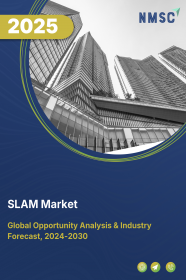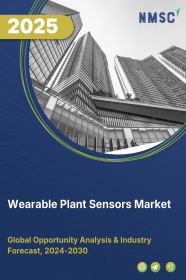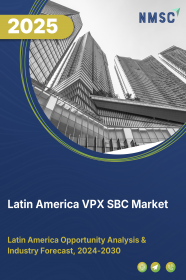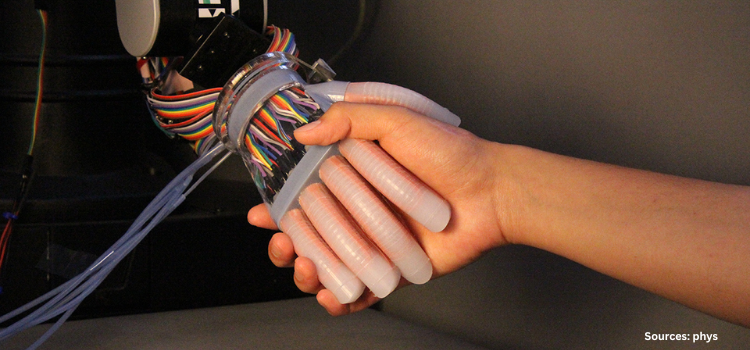
Simultaneous Localization and Mapping (SLAM) Market by Type (Extended Kalman Filter SLAM, Graph-based SLAM, Fast SLAM, and Others), by Solution (Two-dimensional SLAM and Three-dimensional SLAM), by Application (Robotics, Unmanned Aerial Vehicle (UAV), Augmented Reality (AR)/Virtual Reality (VR), and Autonomous Vehicle), and Others – Global Opportunity Analysis and Industry Forecast 2024-2030
US Tariff Impact on SLAM Market
Trump Tariffs Are Reshaping Global Business
Market Definition
The Simultaneous Localization and Mapping (SLAM) Market size was valued at USD 420.5 million in 2023 and is predicted to reach USD 4292.3 million by 2030 with a CAGR of 39.4% from 2024-2030. Simultaneous Localization and Mapping (SLAM) is a technique used in robotics and computer vision to enable robots to explore and operate in unknown environments autonomously. The SLAM algorithm uses probabilistic methods to combine sensor data and make predictions about the environment, allowing robots to operate with a high degree of accuracy and robustness. The SLAM algorithm combines data from various sensors, such as cameras, laser rangefinders, and sonar, to create a map of its surroundings while simultaneously keeping track of its position within that environment. SLAM technology is useful in many applications, such as autonomous vehicles, drones, and search and rescue robots, as it allows them to navigate in unfamiliar and dynamic environments.
Market Dynamics and Trends
The increasing demand for automation in various industries, such as automotive, manufacturing, logistics, and construction, is driving the adoption of SLAM technology. According to the latest report from the International Federation of Robotics, the automotive industry is the largest user of SLAM robotics, with installations reaching about one million units in 2022. SLAM enables robots to navigate and perform tasks in complex environments without human intervention, which is particularly useful in hazardous or hard-to-reach locations.
Moreover, advancements in sensor technologies such as LiDAR, radar, and cameras is further driving the growth of the market as it allows to create more accurate maps and adapt to changing conditions in real-time, increasing reliability and safety of autonomous systems. For instance, in January 2024, Kudan Inc. and Inertial Labs collaborated to launch the RESEPI (Remote Sensing Payload Instrument) scanner featuring Kudan’s 3D Lidar SLAM engine. The RESEPI is designed for UAV-based remote sensing and handheld and backpack-based mapping for high-quality, accurate results in remote sensing applications.
Furthermore, the rising global demand for self-driving cars, equipped with SLAM (Simultaneous Localization and Mapping) technology, is significantly fueling the growth of the SLAM market. These advanced systems enable vehicles to navigate and avoid obstacles in real-time, regardless of lighting or environmental conditions. As the automotive industry continues to embrace autonomous driving technology, the demand for SLAM solutions is experiencing a substantial surge, driving market expansion.
However, high implementation cost of SLAM technology and the central server, which limits robot’s autonomy are the factors restraining the growth of SLAM market. On the contrary, advancements in sensor technology is anticipated to enhance the precision and efficiency of AMRs, offering significant growth opportunities for the market in the future. Sensors such as LiDAR, depth cameras, and inertial measurement units (IMUs) play a crucial role in enabling more accurate and reliable SLAM Navigation AMRs (Autonomous Mobile Robots) by providing detailed information about the robot's surroundings, including obstacle distance, object location, and robot orientation.
Market Segmentations and Scope of the Study
The SLAM market share is segmented on the basis type, solution, application, end-user, and region. On the basis of type, extended kalman filter SLAM, graph-based SLAM, fast SLAM, and others. On the basis of solution, the market is classified into two-dimensional SLAM and three-dimensional SLAM. On the basis of application, the market is divided into robotics, unmanned aerial vehicle (UAV), Augmented reality (AR)/virtual reality (VR), and autonomous vehicle. On the basis of end-user, the market is segmented into military, agriculture & forestry, mining, automotive, manufacturing & logistics, and household appliance. Regional breakdown and analysis of each of the aforesaid segments include regions comprising of North America, Europe, Asia-Pacific, and RoW.
Geographical Analysis
North America holds the dominant share of SLAM market and is expected to continue its dominance during the forecast period. This is attributed to the factors such as growing utilization of SLAM technology in military sector for accurate and real-time mapping in complex and dynamic environments to improve the safety and efficiency of military operations. Also, the growing defense budgets in countries such as the U.S. and Canada is further driving the growth of the market. According to the World Bank, the military and defense expenditure by the U.S. reached USD 800.67 billion in 2021 as compared to USD 778.4 billion in 2020, for the development of advance military devices and technologies including UAVs and ground robots equipped with SLAM technology.
Moreover, the presence of key market players such as Amazon Robotics LLC, Apple Inc, Meta Platforms Inc., and Google LLC., further boost the market growth in the region. These companies play a crucial role in driving advancements, innovation, and market expansion within the SLAM sector in this region. For instance, in June 2022, Amazon launched its first fully autonomous mobile robot named "Proteus" equipped with SLAM technology. The new AMR can work freely around humans and can transport large carts in warehouse and distribution centers.
On the other hand, Asia Pacific is expected to show a steady rise in the growth of the SLAM market. This is due to the growing need of SLAM technology in the automotive industry for automating manufacturing and assembly processes, such as robotic welding, painting, and inspection in this region. According to the International Trade Administration, China is the largest vehicle manufacturing country in the world with domestic production expected to reach 35 million vehicles by 2025.
Moreover, the government initiatives and funding programs to promote robotics equipped with SLAM technology in factories and warehouses to navigate and operate autonomously in complex and dynamic environments is further driving the growth of the market in this region. According to the Center for Strategic & International Studies, China's "Made in China 2025" initiative aims to transform China into a high-tech manufacturing powerhouse, with a focus on robotics and automation in manufacturing industries.
Competitive Landscape
Various market players operating in the SLAM market include Aethon Inc., Amazon Robotics LLC, Apple Inc., KUKA AG, Clearpath Robotics Inc., Gestalt Robotics GmbH, ABB Ltd., SLAMcore Limited, Vision Robotics Corporation, Omron Adept, NavVis, Intel Corporation, Microsoft Corporation, Google LLC, Parrot SA and others. These market players are adopting strategy such as product launch to remain dominant in the SLAM market.
For instance, in March 2022, Locus Robotics launched a new line of warehouse AMRs equipped with SLAM technology such as Locus Vector and Locus Max to its intelligent warehouse execution platform. Through this launch, the company aims to provide fast and efficient warehouse operations such as case-picking, and pallet-picking to in fulfillment and distribution warehouses.
Moreover, in January 2021, Omron launched its new i4 series SCARA robot equipped with SLAM technologies to automate high-speed and high-precision assembly & transportation processes with easy installation. The i4 series consists of an i4H medium to large sized, high-performance model and an i4L that is compact and suitable for lightweight applications.
Key Benefits
-
The report provides quantitative analysis and estimations of the SLAM market from 2024 to 2030, which assists in identifying the prevailing market opportunities.
-
The study comprises a deep-dive analysis of the SLAM market including the current and future trends to depict prevalent investment pockets in the market.
-
Information related to key drivers, restraints, and opportunities and their impact on the SLAM market is provided in the report.
-
Competitive analysis of the players, along with their market share is provided in the report.
-
SWOT analysis and Porters Five Forces model is elaborated in the study.
-
Value chain analysis in the market study provides a clear picture of roles of stakeholders.
Key Market Segments
By Type
-
Extended Kalman Filter SLAM
-
Graph-based SLAM
-
Fast SLAM
-
Others
By Solution
-
Two-dimensional SLAM
-
Three-dimensional SLAM
By Application
-
Robotics
-
Unmanned Aerial Vehicle (UAV)
-
Augmented Reality (AR)/Virtual Reality (VR)
-
Autonomous Vehicle
By End User
-
Military
-
Agriculture & Forestry
-
Mining
-
Automotive
-
Manufacturing & Logistics
-
Household Appliance
By Region
-
North America
-
The U.S.
-
Canada
-
Mexico
-
-
Europe
-
The UK
-
Germany
-
France
-
Italy
-
Spain
-
Denmark
-
Netherlands
-
Finland
-
Sweden
-
Norway
-
Russia
-
Rest of Europe
-
-
Asia-Pacific
-
China
-
Japan
-
India
-
South Korea
-
Australia
-
Indonesia
-
Singapore
-
Taiwan
-
Thailand
-
Rest of Asia-Pacific
-
-
RoW
-
Latin America
-
Middle East
-
Africa
-
Key Players
-
Aethon Inc.
-
Amazon Robotics LLC
-
Apple Inc.
-
KUKA AG
-
Clearpath Robotics Inc.
-
Gestalt Robotics GmbH
-
ABB Ltd.
-
SLAMcore Limited
-
Vision Robotics Corporation
-
Omron Adept
-
NavVis
-
Intel Corporation
-
Microsoft Corporation
-
Google LLC
-
Parrot SA
REPORT SCOPE AND SEGMENTATION:
|
Parameters |
Details |
|
Market Size in 2023 |
USD 420.5 Million |
|
Revenue Forecast in 2030 |
USD 4292.3 Million |
|
Growth Rate |
CAGR of 39.4% from 2024 to 2030 |
|
Analysis Period |
2023–2030 |
|
Base Year Considered |
2023 |
|
Forecast Period |
2024–2030 |
|
Market Size Estimation |
Million (USD) |
|
Growth Factors |
|
|
Countries Covered |
28 |
|
Companies Profiled |
15 |
|
Market Share |
Available for 10 companies |
|
Customization Scope |
Free customization (equivalent up to 80 working hours of analysts) after purchase. Addition or alteration to country, regional, and segment scope. |
|
Pricing and Purchase Options |
Avail customized purchase options to meet your exact research needs. |

















 Speak to Our Analyst
Speak to Our Analyst





















